It was already the next day that we went to visit Gharapuri island near Mumbai. On the island, there are Elephanta Caves that contain artistic pieces linked to the Shiva cult and this site is in the UNESCO’s World Heritage List.
The island is reached by boats that leave from a terminal located right by the Gateway of India, so that at the very beginning, as well as when one is returning, there is a very fine view at the Gateway itself, as well as the famous nearby The Taj Mahal Palace hotel.
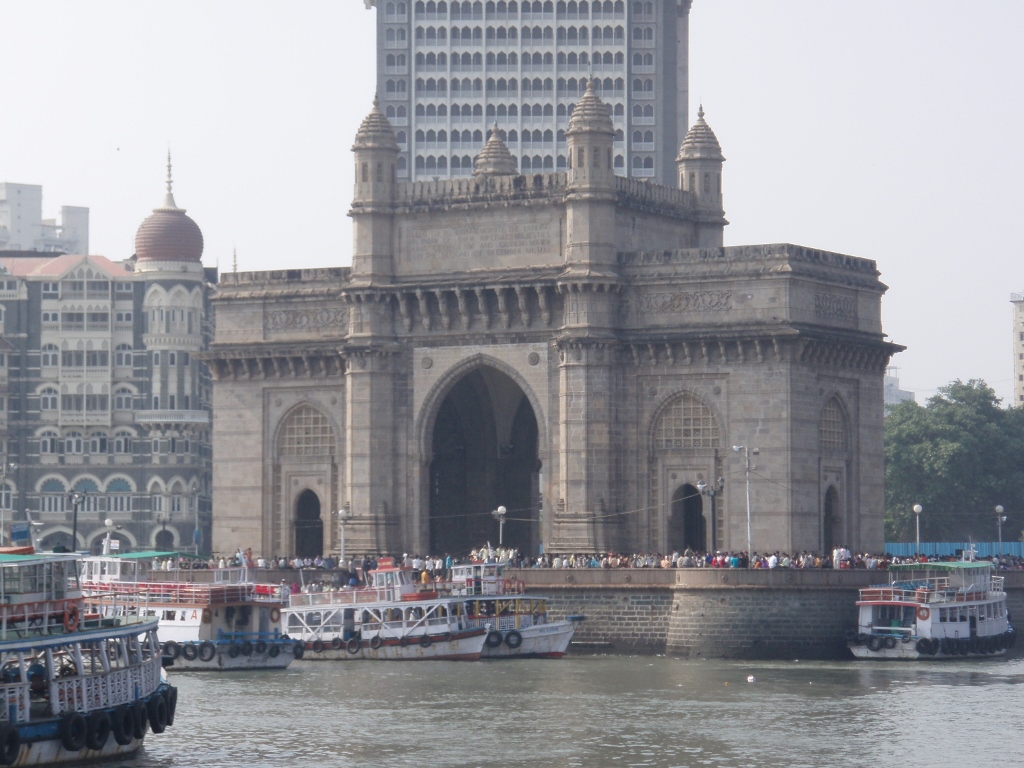 Gateway of India
Gateway of India
This hotel was a target of a terrorist attack in November 2008 (as well as “Leopold” restaurant I mentioned in the previous text on my stay in Mumbai), but I would prefer to have as the association to this hotel a story which in my mind is very nice, moreover didactic, even if the story were not true. Namely, it is said that back in the day, at the end of the 19th century, a very wealthy Indian wanted to enter the Watson’s Hotel, the best hotel in Bombay at the time, but the Brits did not allow him in since the hotel was for “the whites only.” Still, this was not just an ordinary, average Indian, but rather Jamsetji Tata, the founder of the famous Indian business Group Tata and practically the creator of the Indian industries. In a word, this was a very wealthy Indian indeed. The story then goes to say that he wanted to have a hotel which may be entered by whoever wanted to and then he had the Taj Mahal hotel built which nowadays is one of the most famous, most elegant and most expensive hotels. Meanwhile, the Watson’s Hotel stopped being a hotel and exists as a very crumbly building, while the Taj Mahal Hotel shines in all of its beauty and prosperity.
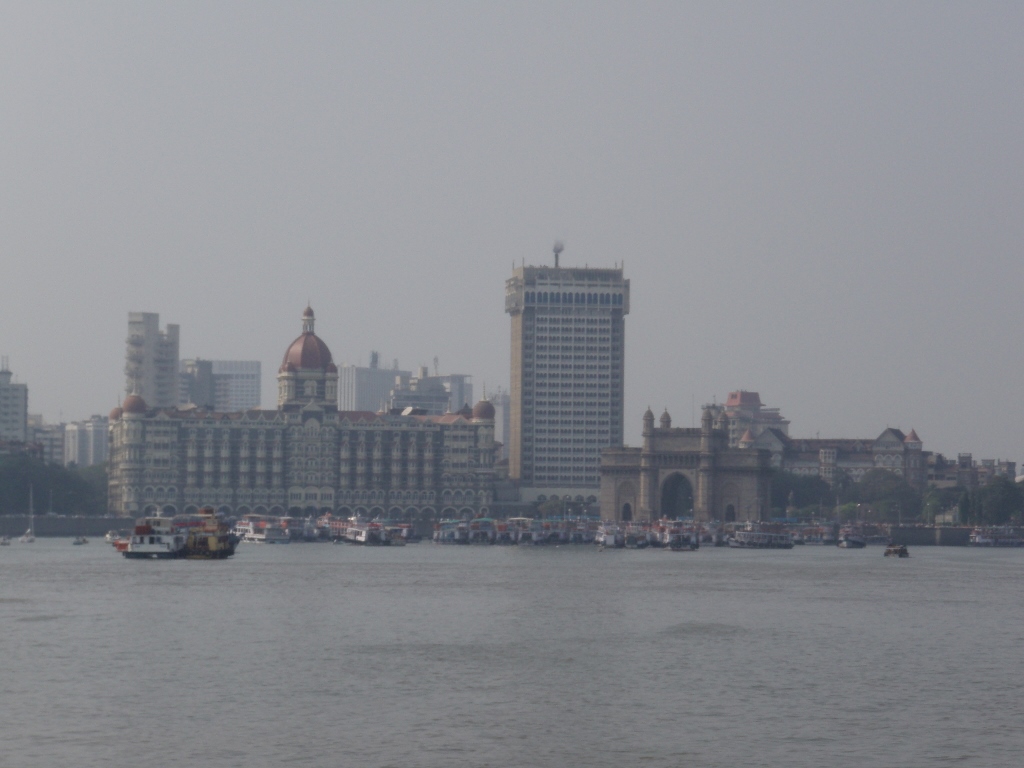 The Taj Mahal Palace hotel (left, with a red dome), a new wing of the hotel (the tall building in the middle) and the Gateway of India (right)
The Taj Mahal Palace hotel (left, with a red dome), a new wing of the hotel (the tall building in the middle) and the Gateway of India (right)
As it can be seen in the photo above, the sky seemed cloudy, but I think that it was actually mist caused by an incredible quantity of humidity. We were still tired of the journey, bad sleep and the change of climate, so the leisurely ride on a boat seemed quite pleasant. When we reached not-too-far-away Elephanta or Gharapuri island and disembarked, we first had to follow a long pier in order to get to the island itself. There was also a narrow rail line on the pier and although I did not see any train or something of the sort, it still seemed to be used to the present days.
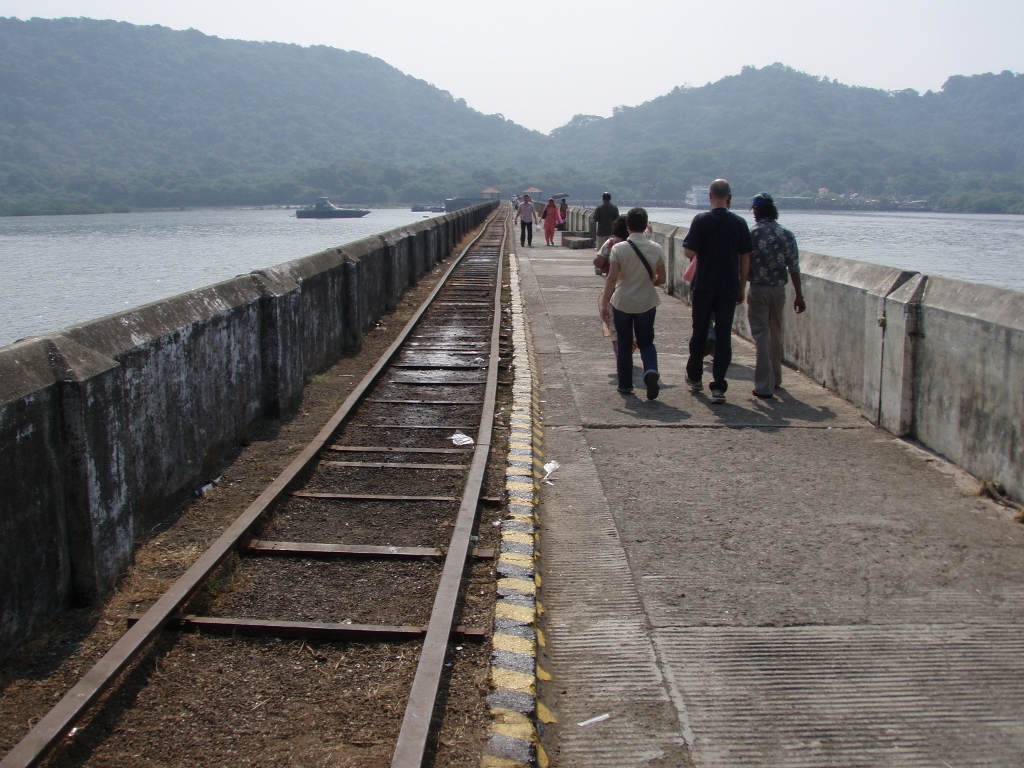 Pier by Gharapuri island
Pier by Gharapuri island
And when you finally reach the island, in order to get to the caves it is necessary to go up 125 steps, which means uphill, but between these steps there were also flat paved sections, so the ascent itself was not too difficult. What made it difficult though was the heat and even more the humidity. The only thing that was good was that there were many stands on both sides, which on the one hand provided something to look at and fine distraction from the ascent and the heat, and on the other all of these stands were covered by canopies that created shade.
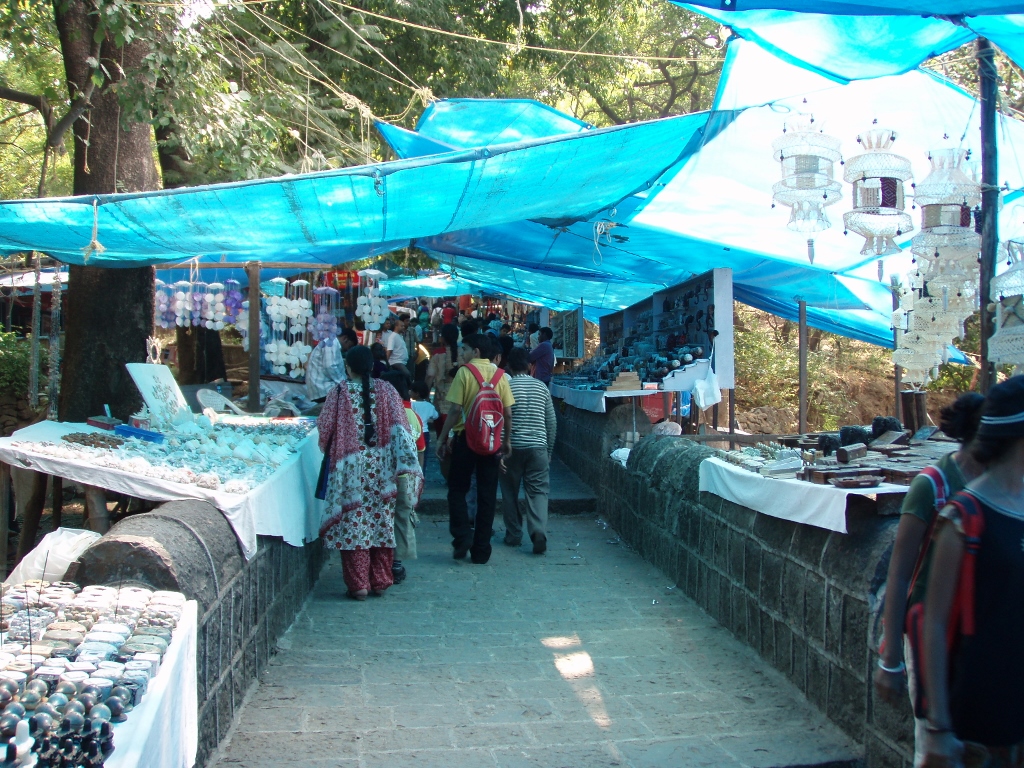 Access to the caves
Access to the caves
Elephanta Caves are in fact a number of temples chiselled out in the basalt rock that may be found on the island. It was this time that we first encountered this “technique” of making temples within rocks (rock cliffs) by practically carving those rocks out. Most probably because of the still present feeling of exhaustion (caused by the travel and change of the time and climate) or perhaps because we did not know quite well what this was all about and when and how this was all made, nowadays it seems to me that we did not enjoy or appreciate this place enough or completely. We certainly had fun and enjoyed it, but I guess we were still novices for India. Luckily, later we saw more of this type of temples and I remember those other impressions much more intensely.
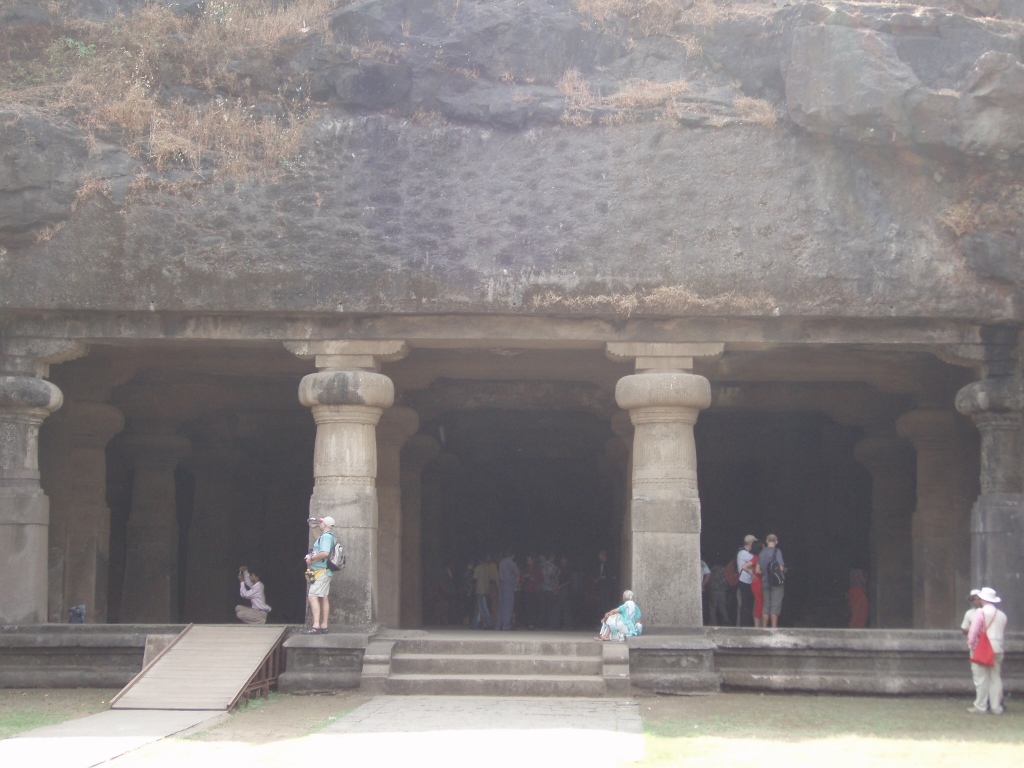 One of the temples within the Elephanta Caves complex
One of the temples within the Elephanta Caves complex
This, however, does not mean that the place was not impressive. Quite the contrary. Between 450 and 750 CE the temples were made on this island that is some 10 km away from the port by the Gateway to India arch. The island used to be called Gharapuri island, but the Portuguese, who ruled Mumbai and its surroundings in the period 1534-1661 called it Elephanta after a sculpture of elephant made of basalt that was located near the entrance. What I find interesting is the story that says that they, the Portuguese, decided simply to take this large sculpture and bring it to Portugal, but the sculpture obviously did not share their enthusiasm and did not want to go on such a long journey, so what happened was that it fell into the sea since the chains and ropes by which it was tied were not strong enough. Later the Brits pulled the sculpture out from the sea and nowadays it is located in the courtyard of one of the museums in Mumbai. Still, the Portuguese name for the island, Elephanta, mostly remained in use, although it is certainly more appropriate to use the original Indian name – Gharapuri.
These “caves” include a number of temples and shrines. Through an inconceivable amount of work and effort, these temples were chiselled out in very impressive size. The temples also go quite deeply into the rock, while the weight of the ceiling, i.e., of the remaining parts of this huge rock that exists above the temples is borne by numerous pillars.
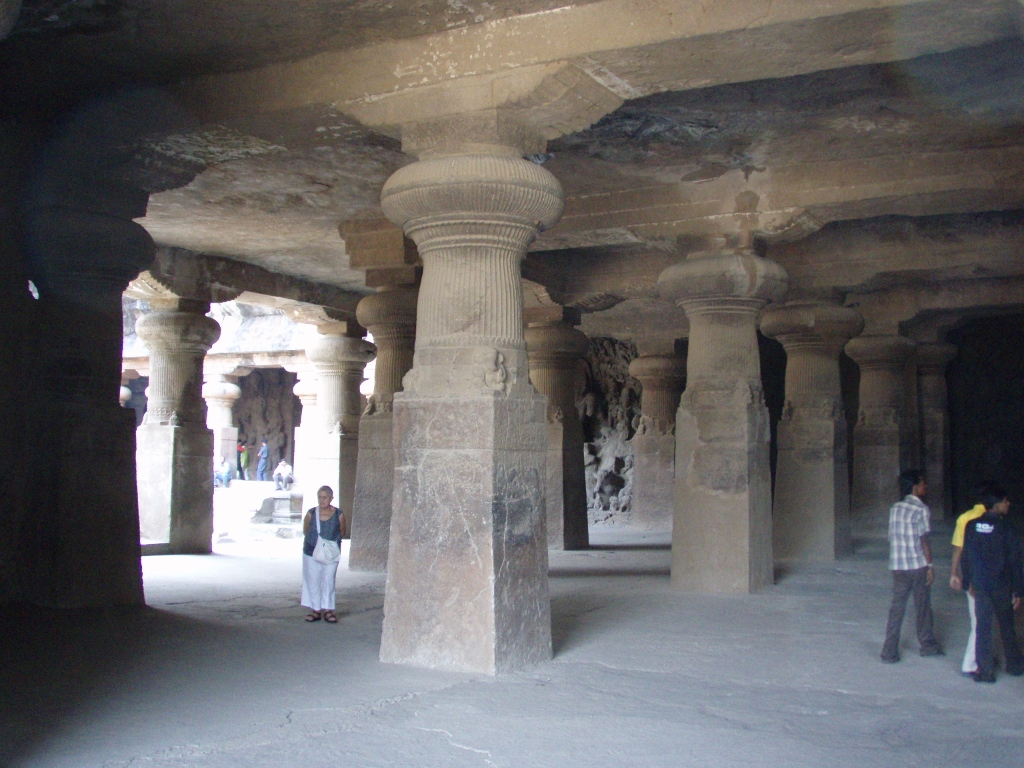 Pillars bearing the load of the ceiling and the rest of the rock
Pillars bearing the load of the ceiling and the rest of the rock
In addition to these numerous pillars made or better said left out during the chiselling of the rock, on some parts of the rock there are also chiselled depictions of different deities. So, one should bear in mind that none of this was “added,” but rather during the construction it was made out of the rock face that was already there.
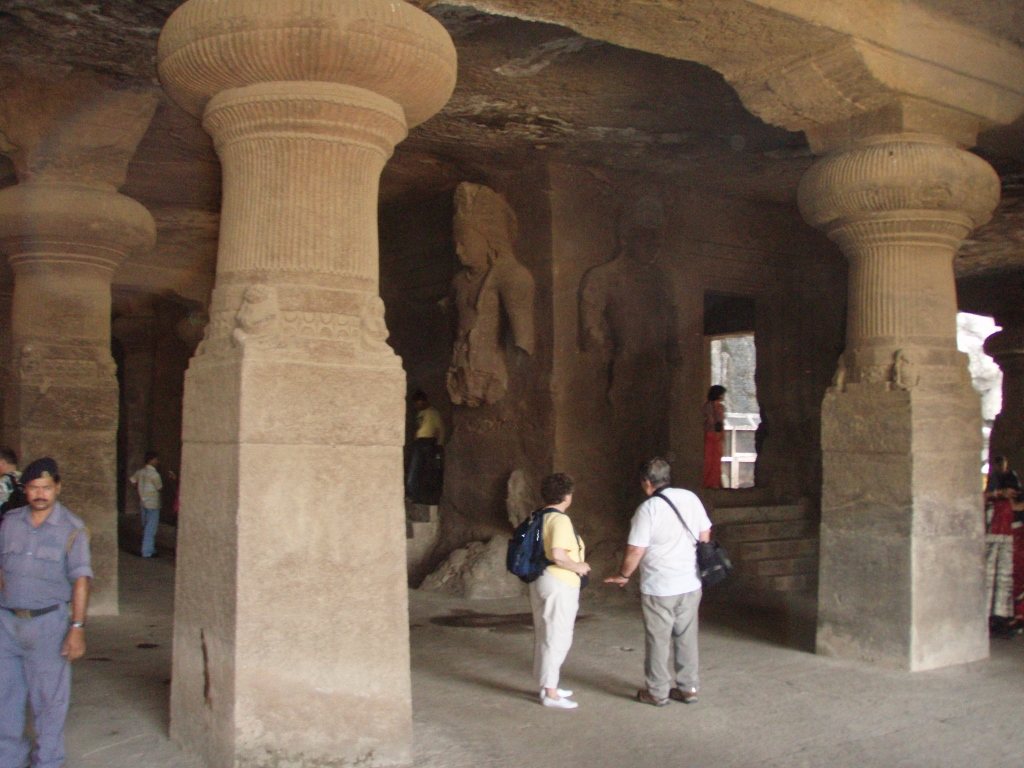 Interior of one of the temples
Interior of one of the temples
In the main cave there is a temple dedicated to God Shiva and down at the farthest end, where the shrine would be, there are three large Shiva’s heads carved in stone and they represent Sadashiva in the form of three faces of Shiva, i.e., three emanations of Shiva – the destroyer, the creator and the preserver of the Universe.
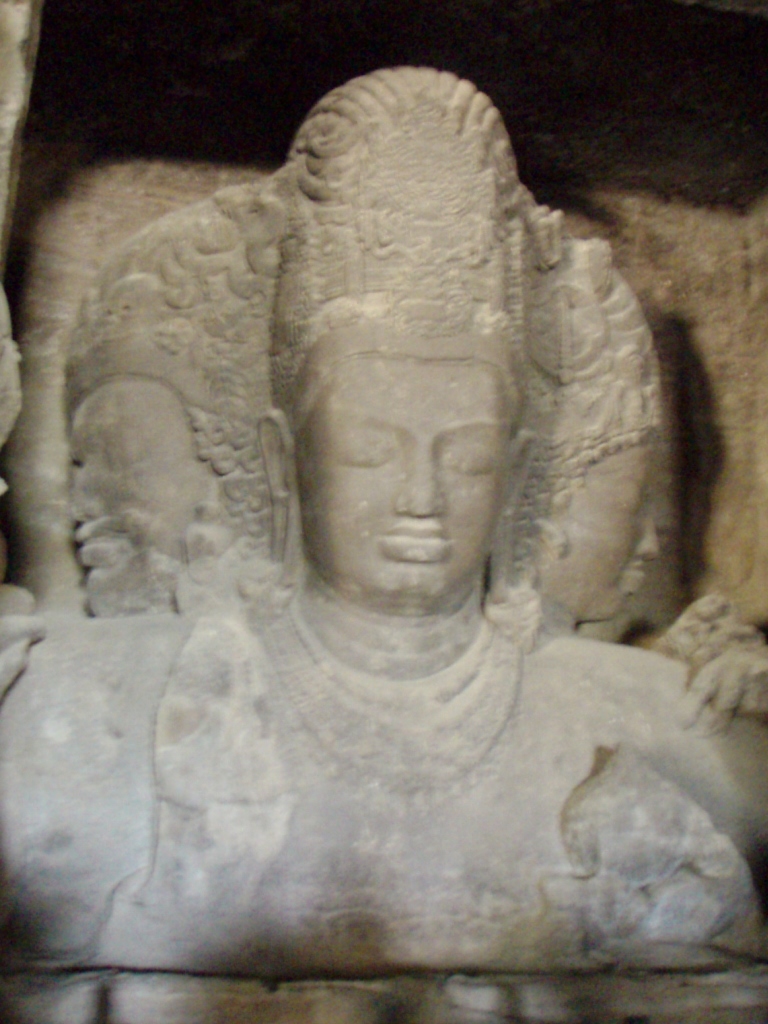 Shiva, the destroyer, the creator and the preserver
Shiva, the destroyer, the creator and the preserver
This sculpture or rather very high relief is completely overwhelming with its height of 7 metres and one should not think that I’m exaggerating. I did not manage to take a photo of anybody next to the depiction of Sadashiva, but here is a photo of another depiction of deities.
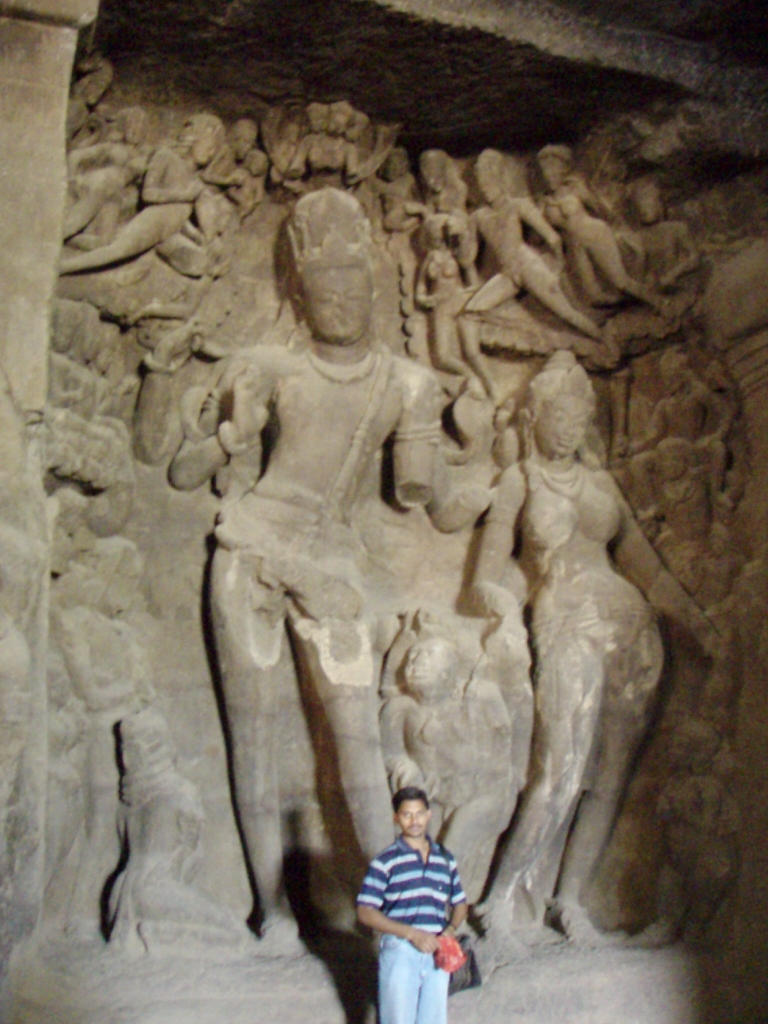 Photo that gives a realistic idea of the size of the reliefs
Photo that gives a realistic idea of the size of the reliefs
By the way, the composition above is called Gangadhara and it shows an emanation of Shiva helping goddess Ganga come down to the Earth, while his consort Parvati and other deities look at this. So, as I’ve said, the Indian art is exceptionally demanding if the visitors are to understand even the basics on account of the complexity of the spiritual stories and legends.
While walking around this complex, Sneža and I were truly impressed, especially taking into account that all of this was carved in the rock. When I say “all of this,” I don’t mean only the three heads of Shiva, but also a number of reliefs with scenes from Shiva’s life that adorn some of the surrounding walls. There are also temples/shrines within the cave complex with carved pieces of rock that resemble an egg or a wide and short pillar of comparatively large size which constitute lingam – a symbol of Shiva.
Although I could partially remember the general story about Hinduism which I had learned back at school a long time ago, this was certainly not even remotely enough to understand much here. Even after this entire journey which lasted almost a month and even later after yet another month spent in India in 2012, I cannot say that I really know much about Hinduism. This is a very complex religion, there are different deities and each one of them has a large number of emanations, each one of them being, of course, very important and having its own special name. On the other hand, as one goes around visiting different shrines and temples, it is necessary to grasp at least the very basic assumptions.
It is important to say that Elephanta Caves are not an active temple, but only an archaeological site. This may also be concluded on the basis of the fact that we all walked here with our footwear on. Later, Sneža and I were to see that before entering any active temple or shrine one must take the shoes off and then continue barefoot.
Walking around the temples and inner courtyards here, we saw a young married couple and the two of us absolutely could not stop admiring her sari. She posed for her husband, so I took the opportunity to make a photo myself. But, here we also started to become aware that the Indians really like having their photos taken. Thus, in the end the two of us took photos of them together, but also let them take a photo of the two of us. It is certain that the two of us seemed as exotic to the two of them as they seemed to us, but I’m sure that they were not, they could not, be equally impressed by our wardrobe, as we were delighted with her sari.
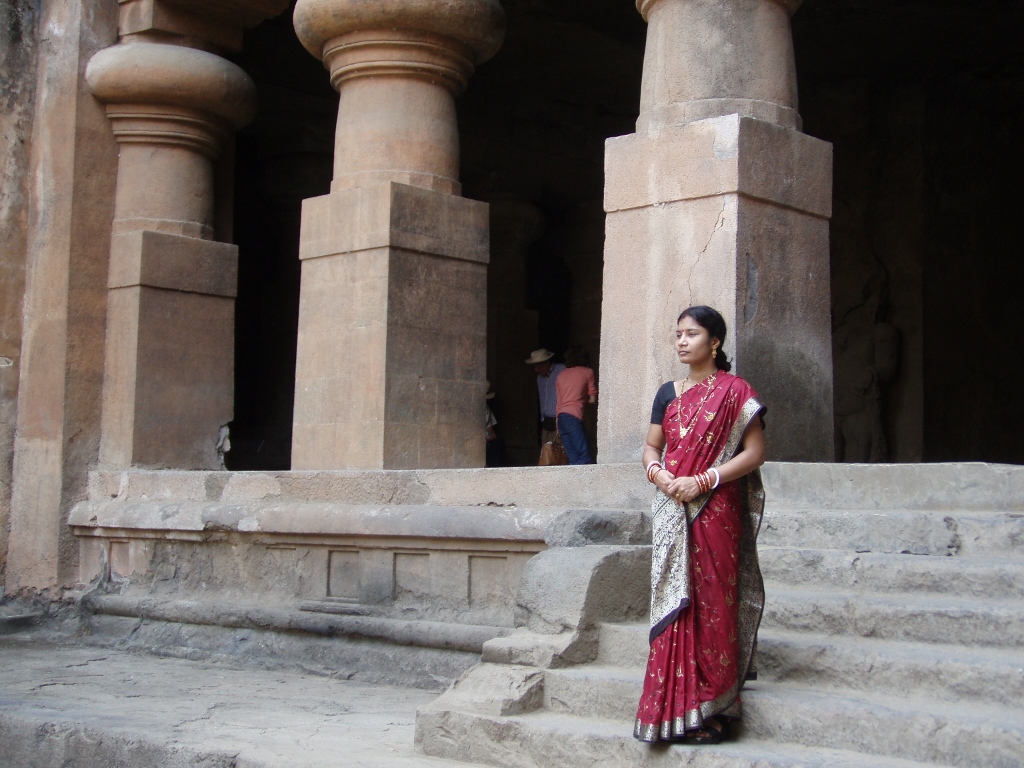 A young Indian woman posing for her husband
A young Indian woman posing for her husband
In-between different temples there are also paved courtyards that can be crossed in order to get from one temple to another.
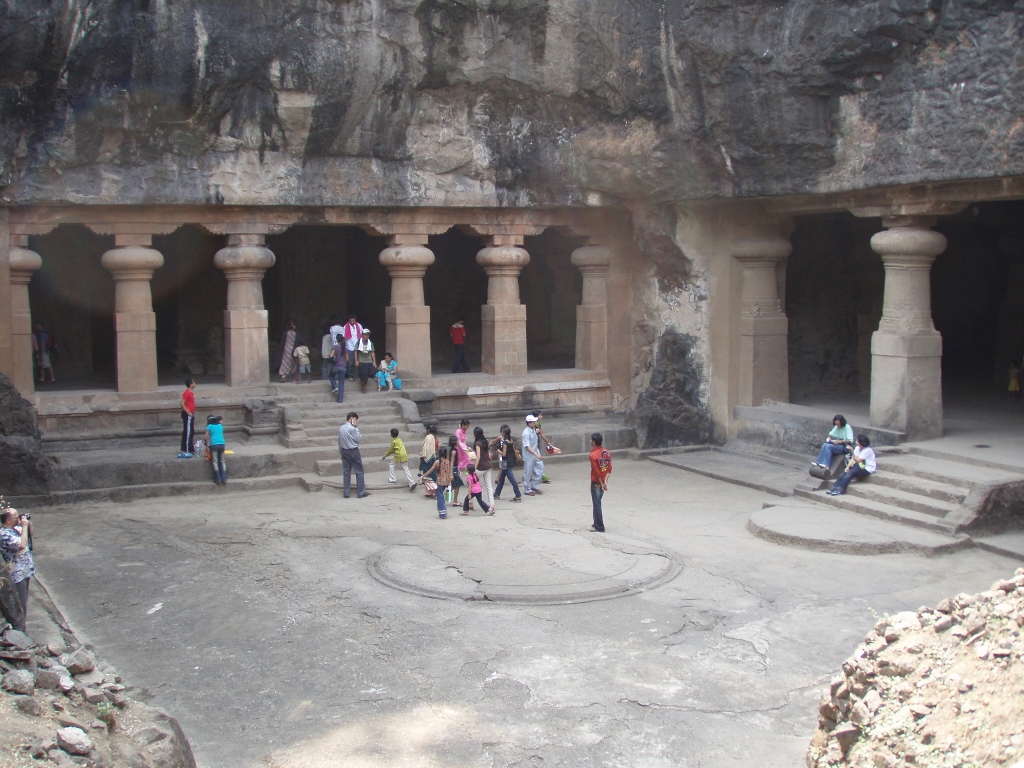 An inner courtyard connecting two temples
An inner courtyard connecting two temples
From the photo above one can get a good impression about what the rock cliff originally used to look like, before people started chiselling it and one can also see the size of the pillars and imagine their numbers. Bear in mind that these temples are rather deep and this can be perceived in some of the photos already provided above.
Close to the access to the caves we also encountered our first local monkeys. There were a lot of them and it was some small-sized species, but I did not find them particularly cute. I did take a couple of photos of them and that was it. All the time I kept in mind the warning Sneža and I had received from a friend who had already been to India before. She had drawn our attention to the fact that these monkeys are wild animals after all and they are known to be aggressive on occasion. They mostly gather in places like this one because of the people who possibly give them food and then with a desire to snatch a piece of it, they can scratch you. Nothing more than that, but we believed we did not need it at all. And so, during our stay in India, Sneža and I often saw monkeys, but we certainly did not feed them.
Since it was Sunday, there were also a lot of local visitors. One family had already spread newspapers on the ground close to the temples and now they were all sitting there together, as if they were on a picnic.
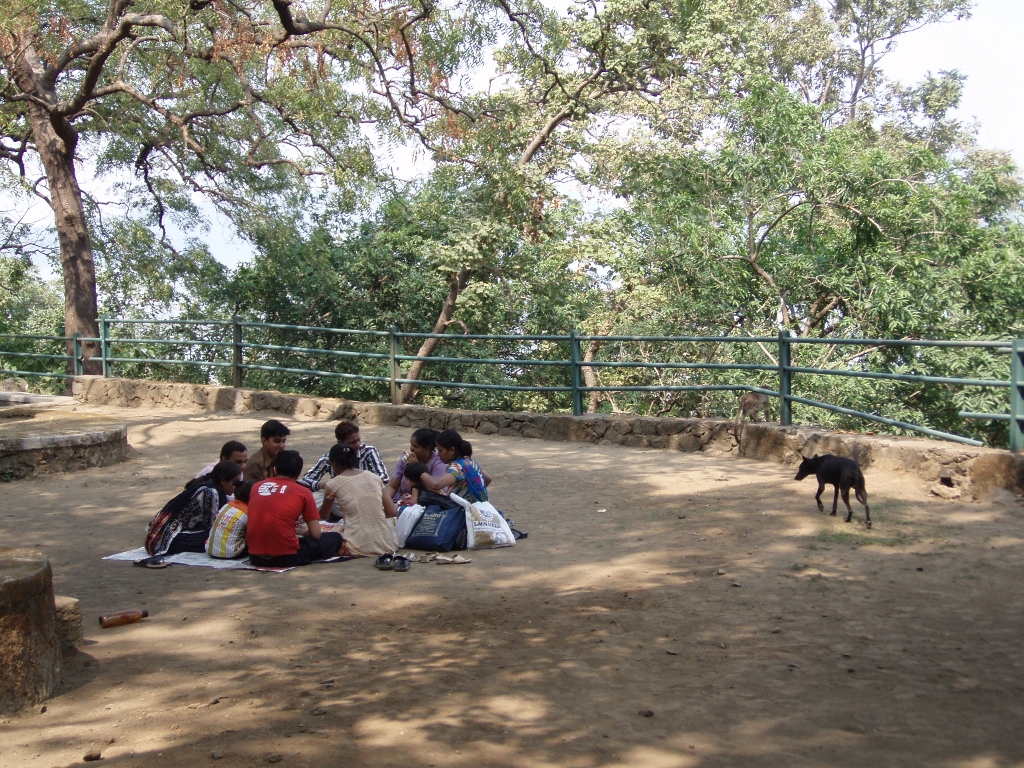 Picnic near the Elephanta caves (there is a monkey by the fence, close to the dog)
Picnic near the Elephanta caves (there is a monkey by the fence, close to the dog)
After the visit to the main cave, we walked around a little, visiting some other caves that are located a couple of hundred metres away and then we slowly headed back, descending down the hill in order to get to the boat.
As we were walking back, we were passing again between the stalls with all sorts of goods and souvenirs. And when we got to the pier, some boys were scrubbing from the outside one of the boats docked there, i.e., they were removing shells and algae that had collected on the body of the boat, while the boys also took this opportunity to play in the water.
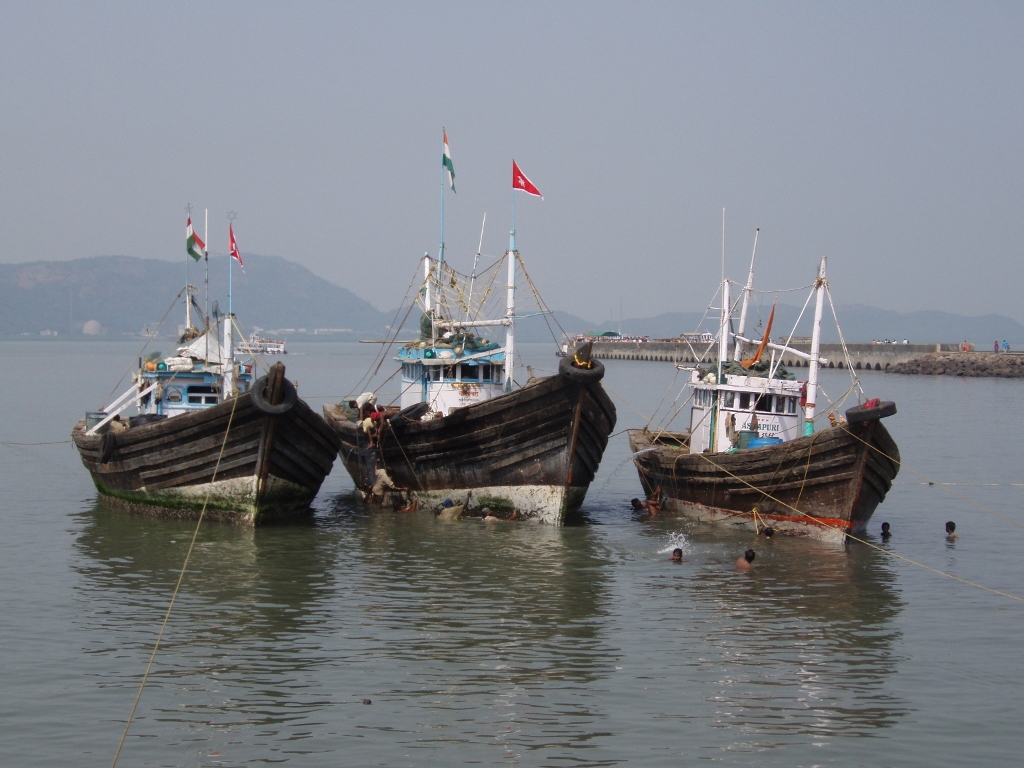 A little bit of work and a little bit of fun
A little bit of work and a little bit of fun
When we got back to the city, we went straight to the Chhatrapati Shivaji Maharaj Vastu Sangrahalaya Museum and this long official name hides within itself the essential meaning “King Shivaji’s Museum.” Earlier, during the British rule and until 1998, the museum was called the Prince of Wales Museum, but this name has been appropriately changed into an Indian name.
This is the biggest and the best museum in Mumbai and we visited it using audio guides, so we could also learn something. Still, there is a huge quantity of items on display and it was very difficult taking all of that in over a period of a couple of hours, but it was good that we at least started to get acquainted with the Indian culture. The problem we had at the museum was the incredibly high air humidity. There were fans working from the ceilings, but this was simply not enough for the two of us, so eventually we did enjoy it when we went outside from the museum.
Since it was my birthday that day, we went to a very nice restaurant and there we had a food blast – there were Indian breads (paratha and roti), main courses made of chicken, prawns and vegetables, and we also had desert at the end. The Indian food was starting slowly to grow on us.
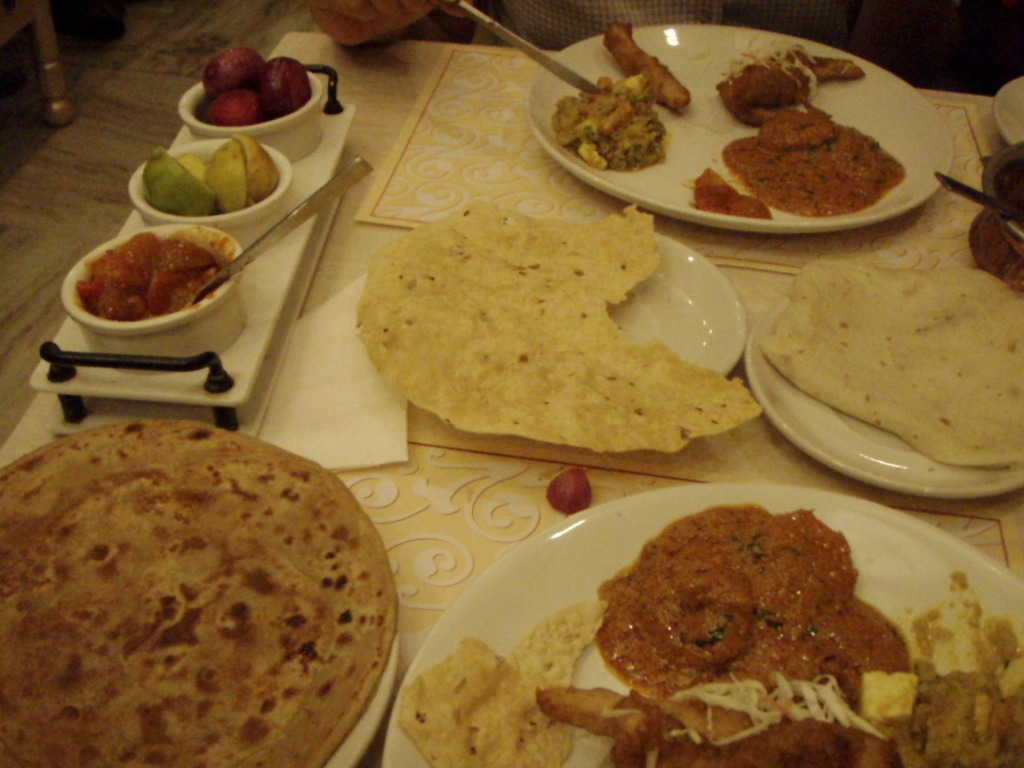 Savoury part of the birthday dinner
Savoury part of the birthday dinner
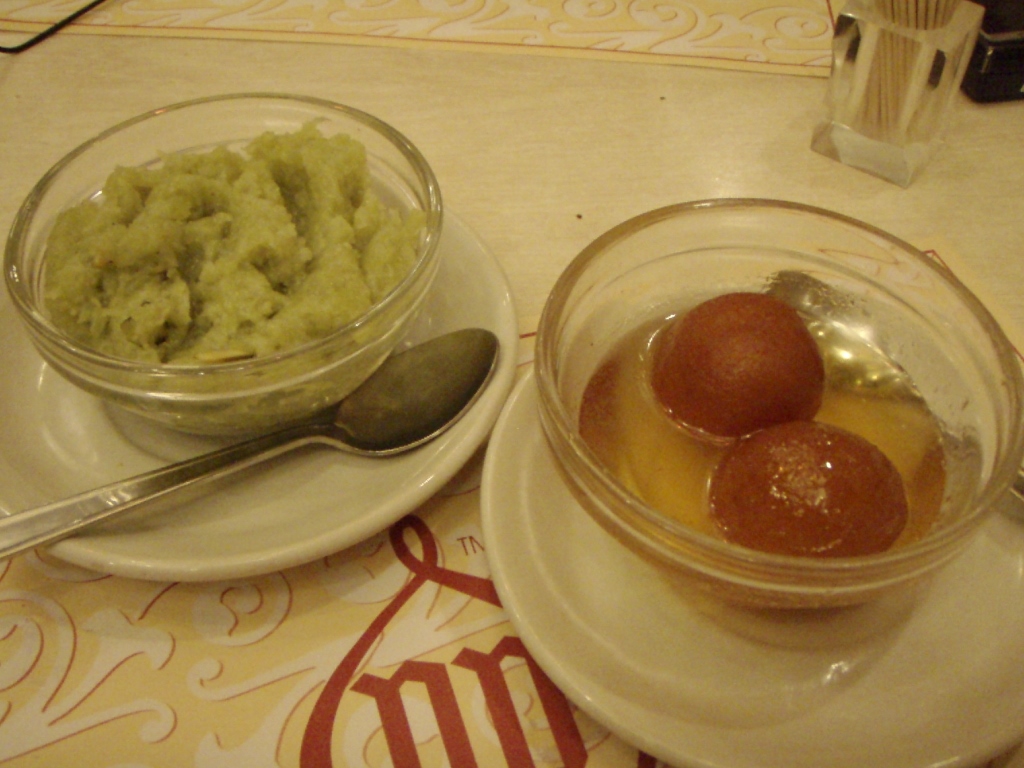 Sweet part of the birthday dinner
Sweet part of the birthday dinner
After that early dinner, we headed for the place from which we would later go for an evening sightseeing tour around Mumbai by a tourist bus. On our way to that point, we passed by a temple that belongs to the Parsis. This was one of their “fire temples” and the access was prohibited for all others who were not of this faith.
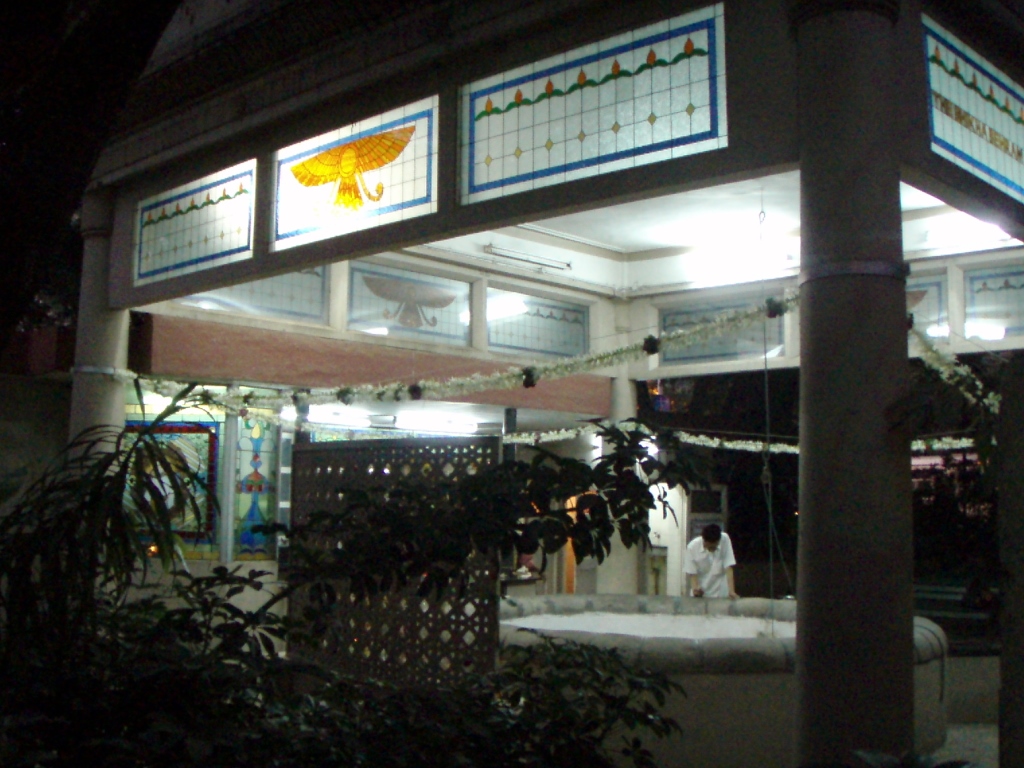 Entrance into the Parsi temple
Entrance into the Parsi temple
The Parsis are an ethnic community originating in Persia and in the period from the 8th to the 10th century they migrated to India. Their religion is called Zoroastrianism and it is based on the teachings of a Persian philosopher and prophet from the 12th century BCE called Zarathustra (or Zoroaster). The then rulers of India accepted them, but under certain conditions, including also a prohibition of proliferating their beliefs, i.e., the impossibility of converting to their religion. There are not many Parsis either in India or in the world and their highest concentration is precisely here in Mumbai.
I’m not going to go into details about this religion now, whoever is interested may research and read about it, but there is something quite interesting that links members of this ethnic group and Mumbai. Namely, as a part of their beliefs, the Parsis do not bury their dead, but rather they leave them out on specially made round platforms called the Towers of Silence. Their bodies are then a feast for scavenger birds, because this is the quickest way to destroy the body without fouling the soil, water or fire (this is linked to the beliefs of the Parsis). However, over the last decades these birds have been almost eradicated in India, including Mumbai, specifically on account of medical drug diclofenac which poisons them by getting to them via cattle that is given diclofenac on a regular basis. This has indirectly created problems for the Parsis and their rituals related to the destroying of the mortal remains of their “co-nationals.” And while the number of the birds continues to be dramatically low, some alternative variants of how to “recycle” human remains are being tested. The testing is ongoing.
On the other hand, regardless of the challenges they face, the Parsis are on an average a rather well-off and an educated ethnic group and they are famous in particular because of their traditional dedication to charity in general. There are only slightly less than 70,000 of them in India, but despite their number being comparatively low, this ethic community includes or rather has included, among others, the above-mentioned industrial giant Jamsetji Tata, as well as the insuperable Freddie Mercury. One other well-known Parsi is the world famous conductor Zubin Mehta.